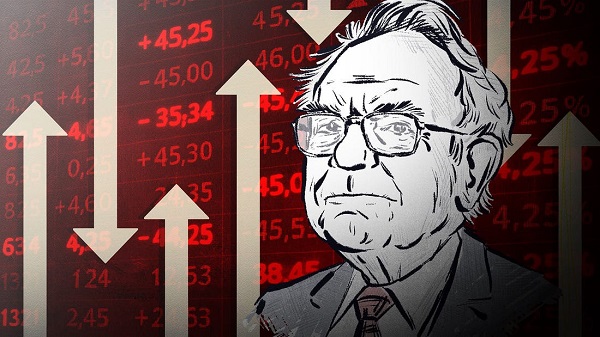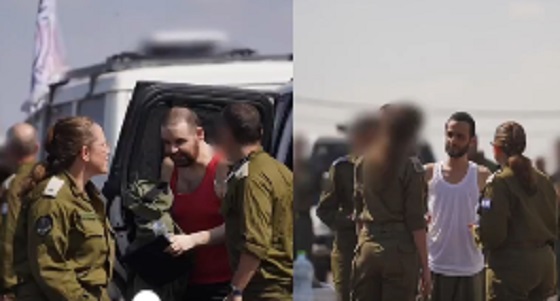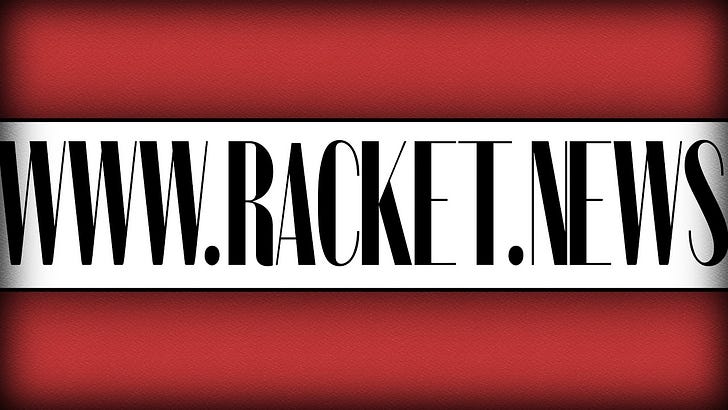Business
The Oracle of Omaha Calls it a Career

By Eric Salzman
Sometimes even the great ones need to get by with a little help from their friends
Warren Buffett announced this month that he will retire from his position as CEO of Berkshire Hathaway, the fabled corporate conglomerate that made him a revered household name, at the end of 2025. Along with a mostly stellar seven–decade investment career, he carefully created an image of a down to earth midwesterner who lives in a modest home, drives a modest car and dines on Dairy Queen (he liked DQ so much he bought the company in 1997) while swigging Coca Cola (another great Berkshire investment) and dispensing sage advise the way your favorite uncle might.
I have a six degrees of separation story where I sort of crossed paths with him. In fact, I can say that I played a small part in Buffett’s dumping of one of his favorite and most profitable trades, Freddie Mac.
Racket News is supported by readers. Consider becoming a free or paid subscriber.
Up until 2000, Warren Buffett’s Berkshire Hathaway owned a big piece of Freddie Mac (he first purchased Freddie stock in 1988), and it was one of Berkshire’s top performers. Buffett has always loved insurance companies, especially ones that generate lots of float (getting cash that you may or may not have to pay out later). That is what Freddie Mac, along with its “rival” Fannie Mae, had in spades. The government-sponsored enterprises had a duopoly on insuring the credit on trillions of American single and multi-family mortgages.
The events that caused Buffett to sell his entire stake in Freddie Mac took place in 1999, right about the time that I arrived at Freddie Mac as the risk manager of one of its divisions.
In February 1999 I was called into a meeting, a top-secret one! Freddie Mac had been sore forever that it was never able to catch up to its big sister Fannie Mae and get a 50% share of the mortgage insurance business. The split always toggled between 55-45 and 60-40 in Fannie’s favor. Freddie had tried many different schemes to achieve parity, and all had failed. Now it was time to go with the nuclear option, kind of like when the Soviet Union put nukes in Cuba.
Freddie made a deal with mortgage giant Wells Fargo. The bank agreed to let Freddie securitize all Wells Fargo loans for two years.
Freddie was confident the deal would allow it to catch up to Fannie Mae. Freddie was also confident that Fannie Mae would just passively accept it.
My small role in this scheme was to approve a massive new three-month credit risk line for Wells. Honestly, the risk that Wells Fargo would go belly up with no warning in any three-month period wasn’t really an issue, so I said sure and signed off.
In the eyes of Freddie, it was a great deal for both sides. Freddie would capture the elusive market share it desired and Wells would be able to insure loans at a cheaper rate, which meant higher profits.
Freddie also made deals with other banks. Wells got the biggest discount, but all were paying less than they were before to insure loans.
Unfortunately, within about a week, Fannie burst Freddie’s parity fantasy by signing up giants like Countrywide, also for much lower insurance rates, and with that, the race to the bottom of mortgage credit insurance was on! Actually, I would say that this was the first event in what would eventually become the Financial Crisis of 2008.
Warren Buffett took one look at this insanity of a duopoly engaging in a bitter price war and sold his entire stake in Freddie Mac. Interestingly, Berkshire was also a big investor in Wells Fargo, so Buffett got to see both sides of this strategy and chose correctly to go with the recipient of Freddie’s largesse, Wells.
However, my man-crush on Buffett ended in 2008.
One additional trait that many found endearing in Buffett was he could be very candid about his occasional losses and mistakes. He would often use these instances to impart some really great advice. However, the one thing I never heard him discuss was the times he should have lost but got the kind of help regular folks don’t get.
Buffett’s long-time business partner, Charlie Munger, once said “Suck it in and cope, buddy” in response to complaints that the government did more to help Wall Street than homeowners during the 2000’s housing crisis.
The truth is, Buffett, Munger and Berkshire would have had to do a lot of sucking themselves if not for the massive government bailout of the financial system in 2008.
This part of the story started between 2003 and 2004. Berkshire made huge option bets that four major global stock indices — the S&P 500, the Nikkei 225, the Euro Stoxx 50 and the FTSE 100 — would not end up lower than they were at the time of the trade, 10 or 15 years in the future. Berkshire sold these options to major Wall Street banks and in return, the banks paid Berkshire approximately $4.9 billion in what are called premiums. If the stock indices ended lower than their current levels, Berkshire would pay the banks the difference and, if necessary, more than the $4.9 billion it was paid.
In turn, if the indices ended at or higher than current levels, Berkshire would get to keep all the money.
Normally, companies that sell these types of long-term options have to put up collateral. Berkshire did not. With Buffet at the helm, Berkshire was considered riskless. This was the key to the strategy. Berkshire could use the $4.9 billion however it wanted without having to tie up any of Berkshire’s other assets.
As long as nothing went horribly wrong, this was a genius move. Buffett would just do his usual brilliant investing with the funds and even if the stock indices ended somewhat lower when the deals expired a decade or two later, the money he would have to pay on the options would probably pale in comparison to the money he would have made with those billions in premiums he received.
Again, unless something went horribly wrong.
In 2008, global equity markets finally woke up to the fact that the subprime mortgage crisis was a giant asteroid hurtling straight for the global financial system and began to free-fall.
At first it appeared Buffett saw what was happening as a great opportunity. One of his famous folksy quotes after all was:
“A simple rule dictates my buying: Be fearful when others are greedy, and be greedy when others are fearful.”
In September of 2008, with Goldman Sachs taking on water with the rest of their Wall Street brethren, Berkshire invested $5 billion in perpetual preferred stock with Goldman. Berkshire would receive a 10% dividend as well as the right to buy $5 billion of common stock at $115 with a five-year term. On the day of the purchase, September 23, 2008, Goldman’s stock was at $125.05. Perhaps Buffett believed Goldman was already saved after AIG was bailed out the previous week. As long as Goldman survived, this could be one of the best returns Berkshire ever made.
However, despite the immediate bailout measures taken to save Goldman and the rest, the hits just kept coming with big banks like Citigroup, Bank of America, Wachovia and WaMu (which went into receivership two days later) on the ropes.
On October 10, 2008, Goldman Sachs’ stock closed at $88.80, down 29% from where Buffett made his Goldman investment just two weeks prior. Moreover, those options Berkshire sold on the four global stock indices, made a few years earlier were going against Berkshire as global stocks cratered.
Everyone needed a bailout, including Berkshire.
Interestingly, a few years after the crisis, CNBC wrote a piece, replete with the customary Andrew Sorkin boot-licking interview.
In October 2008, in the midst of the financial crisis, Berkshire Hathaway CEO Warren Buffett made a late-night phone call to then-Treasury Secretary Henry “Hank” Paulson, with an idea about how the government might be able to turn the economy around.
Paulson was asleep. He’d had a busy night working through various policy ideas with his team to restore confidence in Wall Street.
At the time, Congress had just passed the Emergency Economic Stabilization Act, or the “bailout bill” as it came to be known, and created a $700 billion Troubled Assets Relief Program to purchase assets of failing banks. But these actions were not enough to calm investors
Once he understood what was going on, Paulson says, he listened as Buffett “laid out an idea which was a germ of what we did.”
What he told Paulson, Buffett recalls, is that, “It might make more sense to put more capital in the banks than it would to try and buy these assets.”
Perhaps the CNBC piece should have been called How Warren Buffett Saved Himself During the Financial Crisis.
Remember, just a few weeks before Buffett’s phone call to Paulson, Buffett had put capital into Goldman and now he was losing his ass. The government putting capital into Goldman and the rest of the major banks, at the time, would save him.
Naturally, in a government bailout led by a former CEO of Goldman Sachs, Hank Paulson, the U.S. never exacted the price it should have for saving Goldman and the rest of the major Wall Street banks. In a fair world, the government bailout would have come with major strings attached.
Instead the government, aided by the Federal Reserve, saved the likes of Goldman and Morgan Stanley by giving them federal bank charters, life-saving capital and bailing out AIG. The bailout recipients then profited handsomely in the aftermath due to the Federal Reserve’s unprecedented emergency policies such as zero interest rate policy and the massive buying of U.S. Treasury securities and agency mortgage-backed securities, which the Federal Reserve kept until 2018.
Those bailed out then thanked the government for saving them by giving them back their capital. Incredibly, a Goldman Sachs story on its website says “…the firm had neither sought nor expected such an infusion of capital from the Treasury.” If you need further proof of how laughable this statement is, check out this email from a Federal Reserve Bank of New York official one day before Goldman was given a bank charter.
Berkshire’s large bets on Goldman and the four major global equity indices were also saved and they also ended up richer after the crisis than before.
Meanwhile, the average American was left to “suck it in,” cope and reflect on how greedy and silly they had been buying homes they couldn’t afford.
Warren Buffett was a brilliant investor and a very wise and interesting man. However, in 2008 the “Oracle of Omaha” moniker did not fit. He was just another guy who didn’t quite see just how big the bomb cyclone was that was coming right at him. He and Berkshire escaped financial ruin like all the other plutocrats by relying on Uncle Sam to come to their rescue.
Racket News is a reader-supported publication. Consider becoming a free or paid subscriber.
Business
“Nation Building,” Liberal Style: We’re Fixing a Sewer, You’re Welcome, Canada

Ottawa held a full-blown press conference to announce they unclogged a pipe in Toronto and called it a generational housing strategy.
You probably didn’t hear much about it unless you were watching Canadian state media but this morning, the Liberal government held a press conference in Toronto. It was billed as a “generational investment” in housing. That’s the phrase they used. In reality, it was a sewer project.
Gregor Robertson, the former mayor of Vancouver and now the federal minister of housing and infrastructure, stood beside Toronto Mayor Olivia Chow and a cluster of Liberal MPs to announce that Ottawa is spending $283 million to upgrade the Black Creek trunk sewer line. That’s a pipe. A very old pipe. And according to Robertson, that investment will “unlock” the construction of up to 63,000 new homes in the Downsview area.
If that sounds suspiciously like taking credit for doing your job, maintaining the basic infrastructure cities rely on, that’s because it is. No one has ever accused the Liberals of missing an opportunity to repackage civic maintenance as a national moral crusade. The sewer line is 65 years old. It overflows during storms. It’s been a known problem for decades. Fixing it is not bold housing policy. It’s plumbing.
But the political optics are irresistible. The Trudeau Liberals, now under the leadership of Mark Carney are desperate for a win on housing. Their record is catastrophic. Home prices have doubled. Rents have soared. Entire generations of Canadians have been priced out of ownership and locked into permanent renter status. And the architects of that disaster are now flying around the country handing out ribbon-cutting ceremonies and calling it reform.
Today’s announcement also included the unveiling of the first project under a brand-new federal housing agency, Build Canada Homes. Never heard of it? That’s because it didn’t exist until a few weeks ago. And who’s running it? None other than Ana Bailão a Liberal operative and former Toronto city councillor who spent years helping make the city unaffordable in the first place. Now she’s being rewarded with a cushy federal appointment, tasked with building modular housing and handing out contracts on public land.
And what exactly is Build Canada Homes building? Today, they’re launching 540 homes. Not 63,000… 540. Factory-built units that will be delivered at some undefined point in the future. That’s the big federal breakthrough. A housing crisis affecting millions of Canadians, and Ottawa’s answer is five hundred and forty modular homes in Downsview.
This is the pattern every time. The government breaks something, calls it a crisis, and then demands credit for fixing a fraction of it with your money. The numbers are staggering. According to the Parliamentary Budget Office, Canada needs 3.1 million more homes by 2030 to restore affordability. That means building over 430,000 units per year. Right now, we’re building maybe half that. The backlog gets worse every year. But today, we’re supposed to celebrate because they’re unclogging a sewer and firing up a couple prefab builds on federal land.
No one in the press asked the obvious question: why aren’t private builders constructing the 300,000 units that Toronto has already zoned and approved? Because they can’t. The financing doesn’t work. The cost of materials is too high. Interest rates have crippled developers. And cities like Toronto still impose hundreds of millions of dollars in fees, development charges, and bureaucratic red tape. That’s the real bottleneck. Not the sewer. And here’s what they definitely won’t say out loud: Canada’s housing disaster is not just about supply. It’s about demand, turbocharged by one of the fastest immigration intakes in the Western world. The Bank of Canada has warned repeatedly that immigration targets, set without any link to housing capacity — have blown demand wide open and put relentless upward pressure on rents and home prices.
Mayor Chow admitted it herself, sort of. She said the city has thousands of units ready to build but no takers. And instead of confronting the root causes, monetary policy, taxes, regulatory insanity, the government announces a pilot project and tells you to be grateful. That’s how disconnected they are from reality. They’ve regulated housing out of reach and now they’re posing for photos on a construction site, pretending to be the solution.
And just in case there was any lingering doubt about how deep this failure runs, Statistics Canada released its latest building permit numbers this morning and the trend is exactly what you’d expect in a country where the government makes building homes all but impossible.
The total value of building permits dropped again in August down $139 million to $11.6 billion. Residential permits alone fell 2.4%, driven by steep declines in Ontario and Alberta, the very provinces with the most acute housing needs. Single-family permits fell off a cliff — down more than 10% year-over-year. That’s not a slowdown. That’s a stall.
Meanwhile, British Columbia and Quebec where government intervention is particularly heavy barely managed to offset the damage. The number of new dwellings authorized actually shrank month over month. And this is happening in the middle of a so-called national housing push.
StatsCan didn’t sugarcoat it. They didn’t blame foreign investors or greedy landlords or some phantom market force. They just showed the raw data: Permits are falling. Housing starts are lagging. Builders are retreating.
So let’s just pause here and appreciate the sheer absurdity of what we witnessed. A parade of officials, flanked by branded podiums and tax-funded media handlers, standing in front of a construction site to announce, with straight faces, that they are upgrading a sewer line. And for this, we are told we are “building Canada strong.” Really? That’s the pitch? Fixing basic municipal plumbing is now a nation-building moment?
No! Let’s be clear, you’re not building Canada strong. You’re doing your job. A sewer upgrade in Toronto is not some heroic act of visionary leadership. It’s literally maintenance. It’s what functioning governments are supposed to do, quietly, competently, without a six-camera press choreography and a round of applause from party MPs.
But in Liberal Carney Canada the bar has been lowered so dramatically that simply clearing a permit backlog and patching old infrastructure is treated like a moon landing. They break the system, congratulate themselves for patching one pipe, and expect gratitude.
If you want praise for fixing aging civic infrastructure, something cities used to handle without a national press event, then that tells us everything. It tells us the Liberal government has become so hollow, so addicted to performance politics, that maintenance is now treated as achievement. That’s how far we’ve fallen in just ten years.
They didn’t rebuild a nation. They didn’t launch a housing renaissance. They unclogged a sewer, and are now demanded a standing ovation. And that, in a single image, is modern Liberal Canada: the total collapse of standards, repackaged as progress and sold back to you at full price.
Canadians don’t need more press conferences. They need homes, dignity, and a government that works without constant applause. And if unclogging a pipe is what passes for leadership now — then God help the country.
Subscribe to The Opposition with Dan Knight .
For the full experience, upgrade your subscription.
Business
Finance Committee Recommendation To Revoke Charitable Status For Religion Short Sighted And Destructive

From the Frontier Centre for Public Policy
A new report from the Frontier Centre for Public Policy warns that proposed changes to Canada’s Income Tax Act could have devastating consequences for churches and faith-based organizations nationwide.
Revoking the Charitable Status for the Advancement of Religion: A Critical Assessment, by senior fellow Pierre Gilbert, responds to the 2025 Standing Committee on Finance’s recommendation to remove “advancement of religion” as a recognized charitable purpose.
If adopted, the measure could strip churches, mosques, synagogues, temples and religious charities of their charitable status. The impact would include the loss of income tax exemptions and the inability to issue charitable tax receipts. They could also face a one-time penalty tax that effectively wipes out most of what they own.
“The committee’s recommendation, driven by lobbying from the BC Humanist Association, represents a direct threat to religious freedom and the vital role faith communities play in Canadian society,” said Gilbert. “Religious organizations contribute an estimated $16.5 billion annually to Canada through social services, education, community programs and cultural preservation. Revoking their charitable status would be both fiscally shortsighted and socially destructive.”
The report traces the origins of charitable status in English common law, examines the rise of secularism and fiscal pressures driving the proposed change, and calls on churches to proactively respond through education, advocacy and reasserting their public mission.
Download full PDF here. (30 pages)
-

 Alberta17 hours ago
Alberta17 hours agoFact, fiction, and the pipeline that’s paying Canada’s rent
-

 2025 Federal Election1 day ago
2025 Federal Election1 day agoProtestor Behind ‘Longest Ballot’ Chaos targeting Poilievre pontificates to Commons Committee
-

 Business1 day ago
Business1 day agoUN, Gates Foundation push for digital ID across 50 nations by 2028
-

 COVID-192 days ago
COVID-192 days agoThe Trials of Liberty: What the Truckers Taught Canada About Power and Protest
-

 Brownstone Institute1 day ago
Brownstone Institute1 day agoTrump Covets the Nobel Peace Prize
-

 International1 day ago
International1 day agoHamas releases all living hostages under Trump peace plan
-

 Business1 day ago
Business1 day agoNetherlands Seizes Chinese-Owned Chipmaker in Unprecedented Security Move
-

 Business1 day ago
Business1 day agoTruckers see pay surge as ICE sweeps illegal drivers off U.S. highways










